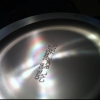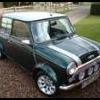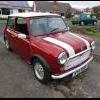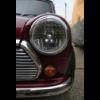
What 'mk' Is My Mini?
#1

Posted 03 June 2011 - 11:48 AM
Thanks
Danny
#2

Posted 03 June 2011 - 11:51 AM
#3

Posted 03 June 2011 - 11:53 AM
#5

Posted 03 June 2011 - 12:33 PM
So at the risk of starting an argument...
Mk 1:
1959 to 1967.
Mk 2:
Introduced October 1967
The front grille shape altered and enlarged, the rear window made bigger and the rear light clusters changed.
Mk 3:
Introduced October 1969
The doors and rear side windows slightly taller and door hinges concealed. The hinge down rear numberplate discontinued and the numberplate light moved from below to above it. The numberplate recess enlarged downwards.
Mk 4:
Introduced May 1976
Rubber mounted front subframe, larger rubber mounts at rear, 20% softer rubber springs, twin-stalk column with indicators on left, bigger pedals.
Mk 5:
Introduced October 1984 (following the Mini 25 anniversary model)
12" wheels and 8.4" disc brakes (previously only seen on 1275GT) on all models. The majority of "Special Edition" Minis (21 in all) are Mk 5s.
Mk 6:
Introduced October 1991
Started with the Mini Cooper 1.3SPi - first fuel injected Mini. Front subframe redesigned to move the engine forward half an inch, washer bottle in boot. Most other changes were transitional e.g. move to 1275 engine on all models (May 1992), walnut facia on Cooper and Mayfair (Feb. 1993), move to single-point injection on all models (1995).
Mk 7:
Introduced October 1996
1.3 Multi-point injection engine with electronic ignition on all models, redesigned block, front radiator, larger alternator, 2.76 diff, driver's air bag, side impact bars, improved sound deadening, sportspack option. Most changes made to meet EC drive-by noise and safety regulations.
Edited by rwerry, 04 June 2011 - 11:10 AM.
#6

Posted 03 June 2011 - 12:34 PM
It's in the FAQ as L400RAS has pointed out. Only problem is, there are two different opinions given. I go along with Guessworks' take on it, which is confirmed by a series of articles written by Tim Mundy in Mini World magazine a decade or so ago.
So at the risk of starting an argument...
Mk 1:
1959 to 1967.
Mk 2:
Introduced October 1967
The front grille shape altered and enlarged, the rear window made bigger and the rear light clusters changed.
Mk 3:
Introduced October 1969
The doors and rear side windows slightly taller and door hinges concealed. The hinge down rear numberplate discontinued and the numberplate light moved from below to above it. The numberplate recess enlarged downwards.
Mk 4:
Introduced May 1974
Rubber mounted front subframe, larger rubber mounts at rear, 20% softer rubber springs, twin-stalk column with indicators on left, bigger pedals.
Mk 5:
Introduced October 1984 (following the Mini 25 anniversary model)
12" wheels and 8.4" disc brakes (previously only seen on 1275GT) on all models. The majority of "Special Edition" Minis (21 in all) are Mk 5s.
Mk 6:
Introduced October 1991
Started with the Mini Cooper 1.3SPi - first fuel injected Mini. Front subframe redesigned to move the engine forward half an inch, washer bottle in boot. Most other changes were transitional e.g. move to 1275 engine on all models (May 1992), walnut facia on Cooper and Mayfair (Feb. 1993), move to single-point injection on all models (1995).
Mk 7:
Introduced October 1996
1.3 Multi-point injection engine with electronic ignition on all models, redesigned block, front radiator, larger alternator, 2.76 diff, driver's air bag, side impact bars, improved sound deadening, sportspack option. Most changes made to meet EC drive-by noise and safety regulations.
Thanks
Edited by danielevison93, 03 June 2011 - 12:35 PM.
#7

Posted 03 June 2011 - 04:34 PM
It's in the FAQ as L400RAS has pointed out. Only problem is, there are two different opinions given. I go along with Guessworks' take on it, which is confirmed by a series of articles written by Tim Mundy in Mini World magazine a decade or so ago.
So at the risk of starting an argument...
Mk 1:
1959 to 1967.
Mk 2:
Introduced October 1967
The front grille shape altered and enlarged, the rear window made bigger and the rear light clusters changed.
Mk 3:
Introduced October 1969
The doors and rear side windows slightly taller and door hinges concealed. The hinge down rear numberplate discontinued and the numberplate light moved from below to above it. The numberplate recess enlarged downwards.
Mk 4:
Introduced May 1974
Rubber mounted front subframe, larger rubber mounts at rear, 20% softer rubber springs, twin-stalk column with indicators on left, bigger pedals.
Mk 5:
Introduced October 1984 (following the Mini 25 anniversary model)
12" wheels and 8.4" disc brakes (previously only seen on 1275GT) on all models. The majority of "Special Edition" Minis (21 in all) are Mk 5s.
Mk 6:
Introduced October 1991
Started with the Mini Cooper 1.3SPi - first fuel injected Mini. Front subframe redesigned to move the engine forward half an inch, washer bottle in boot. Most other changes were transitional e.g. move to 1275 engine on all models (May 1992), walnut facia on Cooper and Mayfair (Feb. 1993), move to single-point injection on all models (1995).
Mk 7:
Introduced October 1996
1.3 Multi-point injection engine with electronic ignition on all models, redesigned block, front radiator, larger alternator, 2.76 diff, driver's air bag, side impact bars, improved sound deadening, sportspack option. Most changes made to meet EC drive-by noise and safety regulations.
I'm not sure that all that's entirely correct as I've got a 1975 mini 1000 and it only has a single indicator stalk on the right and I'm fairly sure that I've got a mk3, but that could just be because my car was manufactured early on.
#8

Posted 03 June 2011 - 04:41 PM
http://www.bmh-ltd.com/minishell.htm
BMP0343 Mk IV standard body complete
AAA36002 Mk IV body complete for Tbi engine
AAA360200 Mk V standard body complete
AAA360210 Mk V Sports Pack body complete
What do these relate to and what is the Tbi engine?
#9

Posted 03 June 2011 - 06:55 PM
As far as I can see the list above is correct in all but the start date for the Mk4 which should be 1976.
#10

Posted 03 June 2011 - 07:12 PM
#11

Posted 04 June 2011 - 11:22 AM
I'm not sure that all that's entirely correct as I've got a 1975 mini 1000 and it only has a single indicator stalk on the right and I'm fairly sure that I've got a mk3, but that could just be because my car was manufactured early on.
You are quite right. The date for the Mk 4 was a typo on my part. As Dan has said, it should read May 1976, NOT May 1974.
For the record, I have corrected my original post. Apologies for the confusion.
#12

Posted 21 July 2011 - 04:51 PM
i have a 1976 mini 1000 and all it has from that list is the twin stalk steering colum although it was registered in august 1976 could this be one of the last mk3s or one of the first mk4s.It's in the FAQ as L400RAS has pointed out. Only problem is, there are two different opinions given. I go along with Guessworks' take on it, which is confirmed by a series of articles written by Tim Mundy in Mini World magazine a decade or so ago.
So at the risk of starting an argument...
Mk 1:
1959 to 1967.
Mk 2:
Introduced October 1967
The front grille shape altered and enlarged, the rear window made bigger and the rear light clusters changed.
Mk 3:
Introduced October 1969
The doors and rear side windows slightly taller and door hinges concealed. The hinge down rear numberplate discontinued and the numberplate light moved from below to above it. The numberplate recess enlarged downwards.
Mk 4:
Introduced May 1974
Rubber mounted front subframe, larger rubber mounts at rear, 20% softer rubber springs, twin-stalk column with indicators on left, bigger pedals.
Mk 5:
Introduced October 1984 (following the Mini 25 anniversary model)
12" wheels and 8.4" disc brakes (previously only seen on 1275GT) on all models. The majority of "Special Edition" Minis (21 in all) are Mk 5s.
Mk 6:
Introduced October 1991
Started with the Mini Cooper 1.3SPi - first fuel injected Mini. Front subframe redesigned to move the engine forward half an inch, washer bottle in boot. Most other changes were transitional e.g. move to 1275 engine on all models (May 1992), walnut facia on Cooper and Mayfair (Feb. 1993), move to single-point injection on all models (1995).
Mk 7:
Introduced October 1996
1.3 Multi-point injection engine with electronic ignition on all models, redesigned block, front radiator, larger alternator, 2.76 diff, driver's air bag, side impact bars, improved sound deadening, sportspack option. Most changes made to meet EC drive-by noise and safety regulations.
I'm not sure that all that's entirely correct as I've got a 1975 mini 1000 and it only has a single indicator stalk on the right and I'm fairly sure that I've got a mk3, but that could just be because my car was manufactured early on.
1 user(s) are reading this topic
0 members, 1 guests, 0 anonymous users


















